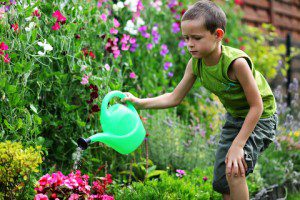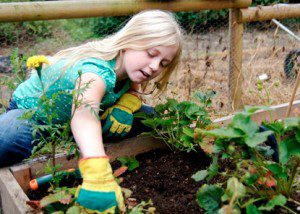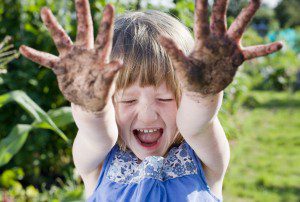 Life-long health begins with regular doses of outdoor activity starting at a young age.
Life-long health begins with regular doses of outdoor activity starting at a young age.
There is a paradigm shift starting to take place in children’s health and education, as parents and educators rediscover the physical and emotional benefits offered by outdoor activity and exposure to the natural elements — air, water, sunlight and earth — and how these impact a child’s healthy heart and brain development.
Inherent to this shift is bringing joy back into the heart of the learning process. This means consciously incorporating “natural activity” that promotes meaningful heart-centered and earth-centered learning. Here are some examples of simple learning activities that engage curious minds, bring joy, get the heart muscle pumping and allow for the natural elements to deliver exactly what healthy hearts and growing minds need.
♥ Raking and jumping in piles of leaves in the fall while learning about mulch, soil nourishment and why leaves turn color and fall.
♥ Shoveling pathways and building snow forts in the winter while learning about temperature, water, ice crystals and hibernation.
♥ Digging garden beds and planting seeds in the spring while learning about garden care and how fruits, vegetables and herbs are grown.
♥ Hiking through the woods in the summer, studying wild plants and identifying reptiles, birds, spiders, ticks and insects.
Air
Interactive outdoor activity provides the opportunity to laugh, inhale fresh air and to breathe deeply into the heart. Oxygen accounts for one-fifth of natural air we breathe. It is absorbed into the blood stream through the lungs in order to fully activate the heart and fuel cellular activity all throughout the body.
 Elementary school children spend a lot of time sitting in school desk chairs, slumped over papers, books and sometimes computer pads. This posture compresses the lungs and therefore reduces the amount of air going to the lungs, the heart, the body and the brain. An hourly activity break of 10 minutes will increase oxygen intake, open up the heart, re-energize the body and increase alertness, focus and productivity.
Elementary school children spend a lot of time sitting in school desk chairs, slumped over papers, books and sometimes computer pads. This posture compresses the lungs and therefore reduces the amount of air going to the lungs, the heart, the body and the brain. An hourly activity break of 10 minutes will increase oxygen intake, open up the heart, re-energize the body and increase alertness, focus and productivity.
These breaks also serve the same purpose as adult ‘coffee breaks’; they are a time to allow children to talk, share ideas and experiences, laugh, connect heart-to-heart with one another and grab a drink of water.
Water
More than 60 percent of the human body is water. Blood is roughly 92% water, the brain and heart are around 75% water, and the lungs are about 80% water. [1] Consuming regular doses of water allows the blood to flow more freely, enables the heart to pump more easily around the body (including the brain) and reduces blood pressure. While spending long periods of time outdoors, children should have a bottle of water on hand, along with a nourishing snack that is high in natural nutrition and high in water content, such as fruits and raw vegetables.
 Sunlight
Sunlight
Natural light energy from the sun increases the body’s production of vitamin D and serotonin, a hormone that boosts mood and promotes happiness.
In addition, exposure to the electromagnetic rainbow spectrum of sunlight is said to activate and balance the seven chakras of the soul. The heart chakra is at the center of the chakra system. It is prudent, nonetheless, to prevent overexposure to ultraviolet rays, which can damage skin. One must determine the proper amount of time exposure for a person’s particular skin type. This will change with the seasons and vary depending on how far north or south a person lives on the Earth.
Earth
Scientists are finding that regular physical contact with the earth is important to the body’s electrical systems. Electromagnetic radiation from computers, toxic chemicals in the environment and unhealthy foods cause the human body to accumulate unstable free radicals, which are harmful to the body. Physical contact with the earth allows for the exchange of electrons to neutralize the free radicals and stabilize the body. This process of contact is called earthing or grounding. Preliminary scientific research shows that earthing improves blood flow, regulates heart rate and rhythm, increases immunity and reduces stress.
 Jumping in leaves, building snow forts, planting seeds and hiking are all activities that connect children directly to the earth.
Jumping in leaves, building snow forts, planting seeds and hiking are all activities that connect children directly to the earth.
Nature’s Remedies
While natural prescriptions like physical activity, air, water, sunlight and earth are readily and freely available, pharmaceutical companies continue to push sales of chemically-derived medications, which they claim treat everything from diabetes and high blood pressure to anxiety and insomnia. Current data from the Centers for Disease Control and Prevention shows that today nearly one in five high school boys in the U.S. is diagnosed with attention deficit hyperactivity disorder (ADHD), and about one in 10 takes ADHD medication intended to help them focus and keep on task. These drugs are costly, may have adverse side effects and could lead to addiction and drug abuse.
A minimum daily requirement of 45 minutes of outdoor activity throughout the developmental years can help reverse this alarming trend of teen drug use. Walking, fresh air, spring water, sunlight exposure and earth contact are free natural remedies that can help reduce symptoms of disease and minimize reliance on risky and costly drug therapy.
“Heart-Centered Learning for a Happy, Healthy Child”, by Wendy Nadherny Fachon, March 28, 2015
Original link: Heart-Centered Learning for a Happy, Healthy Child

